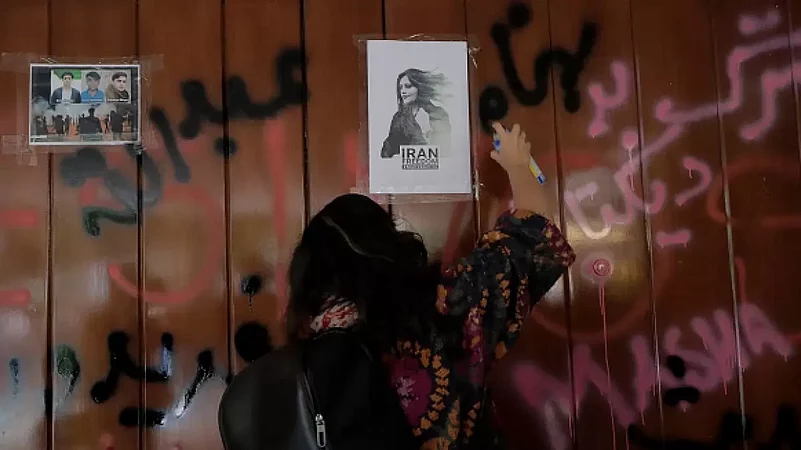In September last week, feminist activists in Iraq launched a social media campaign demanding the issuance of an official decision by the Ministry of Education that will prohibit "the imposition of the veil as a condition for academic admission". Through the hashtag #No_for_forced_veiling?on Iraqi social media websites, the online campaign, that emphasised the importance of the personal freedom of women, became another example of how cyberfeminism is taking a dynamic shape in the Middle-east and South Asian countries.
How Cyberfeminism Is Helping Women Forge Solidarities In Conservative Societies
Cyberfeminism has attracted attention the world over and women are coming together online through various social media campaigns to offer solidarity with those under theocratic or politically conservative regimes.

The online campaign comes at a time when social media has been flooded with anti-hijab protests following the death of 22-year-old Mahsa Amini, who was reportedly beaten to death after being arrested for “improperly” wearing a hijab. Amini’s death has sparked street-wise protests with visuals going viral online. Women burned their headscarves to protest laws that force women to wear the hijab. Fearing the spread of unrest, the Iranian government has almost completely shut down the internet.
Unlike the west, many Middle-east countries stay behind in terms of recognising?equal rights and opportunities for women in every walk of life.?To these women, the cyberfeminist?movement, plying via various social media channels including Facebook, Instagram, Telegram, and Twitter has become an important tool for social change, activism, revolution and debates about gender rights.
What is cyberfeminism?
The term was coined in the early 1990s with no proper definition to define its activism. According to media reports, the term can be attributed to either the director of the Cybernetic Culture Research Unit at the University of Warwick, or to the VNX Matrix, an Australian artist collective that penned The Cyberfeminist Manifesto for the 21st Century in 1991. (“We are the virus of the new world disorder,” the manifesto reads, “rupturing the symbolic from within saboteurs of big daddy mainframe.”).
Cyberfeminism has been viewed in two ways --- to break into the ‘male-dominated’ space of the internet and technology and to spread the ideals of feminism through the tools of social media.
How has cyberfeminism helped in mitigating movements across the globe?
An example of cyberfeminism can be traced back to June 2009 uprising following Iran's presidential election that sparked the immediate scattering of its women's rights leaders across the globe. Activists living in exile took their activities online to pursue on-the-ground projects, initiating online campaigns and raising feminist awareness.
In the Gulf countries, the protest that followed the Arab Spring, which began on 17 December 2010 and continued till December 2012 against the authoritarian regimes in West Asia and North Africa, saw largescale use of social media by activists who strongly protested against the suppression of Arab women and their rights.
Following the 2012 Nirbhaya rape, the anti-rape movement in India launched a new feminist politics that embodied a rights-based discourse of gender in a way that had not been seriously taken up by the mainstream Indian Women’s Movement. Many experts view that this feminist discourse was connected to a global vocabulary of rights facilitated, to a large extent, by means of the Internet.
In the Iran anti-hijab row, social media has been flooded with women chopping off their hair and burning veils, encouraging each other to join the movement against the forceful imposition of wearing a Hijab. Women posting on social media with the campaign hashtag #notocompulsoryhijab, have attracted reactionary tweets accusing them of being anti-Islam and anti-society. Women who use their social media accounts to reject the hijab are often met with sexist attacks and threats that attempt to shame and silence them.
Cyberfeminism, at large, has attracted attention and women are coming together online through various social media campaigns to offer solidarity with those under theocratic regimes.
In Pakistan, several feminist movements including Women’s Democratic Front (WDF) and Women Action Forum have taken a shape largely by claiming their space and encouraging others to do so as well on social media. These movements have set the online debate on society’s set rights and wrongs, which have helped people develop their own independent perspectives.
With information, readily available and accessible online, social media have been used by feminists and activists for socializing and advocacy, which has helped in pushing back patriarchy to a point.
-
Previous Story
 'I Don't Know': Champai Soren Denies Rumours Of Switch To BJP; Himanta Sarma Praises His Contribution In Jharkhand
'I Don't Know': Champai Soren Denies Rumours Of Switch To BJP; Himanta Sarma Praises His Contribution In Jharkhand - Next Story


















